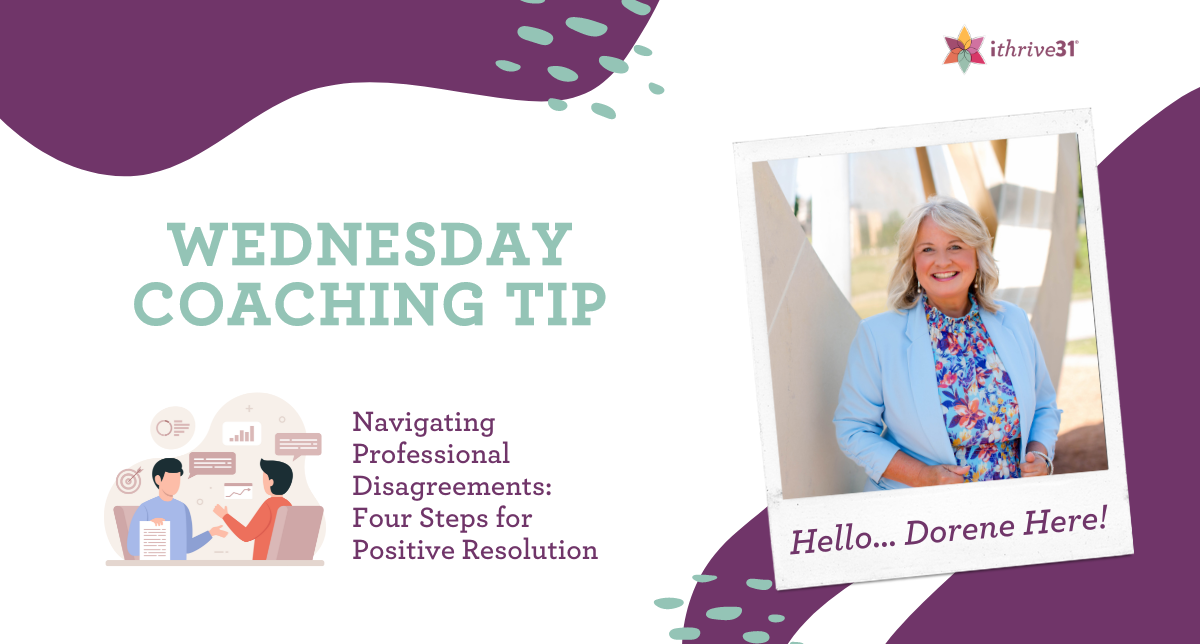
Navigating Professional Disagreements: Four Steps for Positive Resolution
In today’s society, disagreements are increasingly common, extending into the workplace where differing approaches, styles, or opinions are to be expected. How we handle these disagreements significantly impacts our well-being and influences those around us, including coworkers and children.
The other day, a client and I were having a conversation about her boss, who was taking credit for a project her team worked on. She was feeling very angry and resentful. She was ready to “take on this issue” and she had scheduled a meeting to let him know how this impacted her and the rest of the team. Her emotions were energized.
The Importance of Positive Conflict Resolution
Handling professional disagreements effectively is crucial. It not only maintains a healthy work environment but also sets a positive example for others. Let’s explore four steps to navigate professional disagreements constructively.
1. Understand Your Own Reaction
Before addressing a disagreement, take time to understand your own emotions and why they arise.
- Identify Your Emotions: Are you feeling anger, resentment, jealousy, fear, etc.? Documenting these emotions can provide clarity.
- Reflect on the Source: Consider why you feel committed to your position. Is it tied to your values, beliefs, insecurities, or past experiences?
Example
In the case of my client, her anger stemmed from a sense of fairness and responsibility to her team. Understanding this helped her approach the situation more thoughtfully.
2. Consider Their Perspective
Understanding the other person’s motivations can provide valuable insights.
- Empathize: Try to see the situation from their viewpoint. What values or pressures might be influencing their behavior?
- Ask Questions:
- What is important to them?
- Why might they feel this way?
Example
We considered that my client’s boss might have felt pressured to highlight the team’s success to his superiors, possibly unaware he was taking undue credit.
3. Decide How You Want to Show Up
Your approach can greatly influence the outcome of the disagreement.
- Define Success: What does a successful resolution look like?
- Communicate Effectively: Aim to present your perspective clearly and listen with empathy.
- Maintain Professionalism: Focus on solutions that honor your values and preserve the relationship.
Example
My client decided to communicate her team’s contributions clearly while expressing empathy for her boss’s potential pressures.
4. Reflect on the Outcome
Every disagreement is an opportunity to learn and grow.
- Assess the Situation: What did you learn from the disagreement?
- Consider the Impact: How did your approach affect the resolution and your relationships?
- Plan for the Future: Use these insights to handle future disagreements more effectively.
Example
My client considered her approach, which focused on understanding and empathy, improving her relationship with her boss, and setting a positive example for her team.
Conclusion
Navigating professional disagreements effectively is not about winning arguments but about growing and making a positive impact. By managing disagreements well, you contribute to a healthier work environment and set a constructive example for those around you.
_____________
ithrive31 blends leadership coaching and life coaching—guiding leaders and professionals to unleash their full potential in order to thrive at work and at home. If you enjoy our content, we invite you to subscribe to our newsletter here.
Meet our coaches:
Miki Huntington, M.A., CPC Lauren Foxwell, MBA Stacey Walter Dorene MacVey, PCC Marli Overman, PHR, CPC

